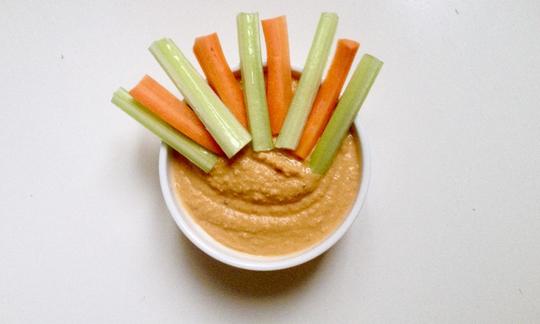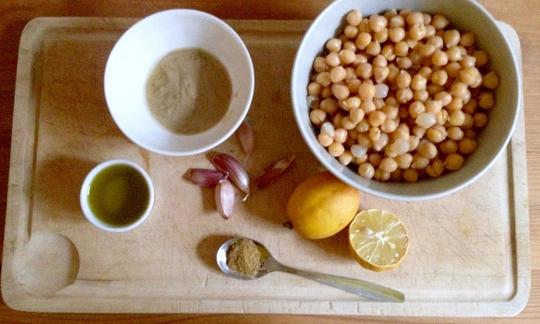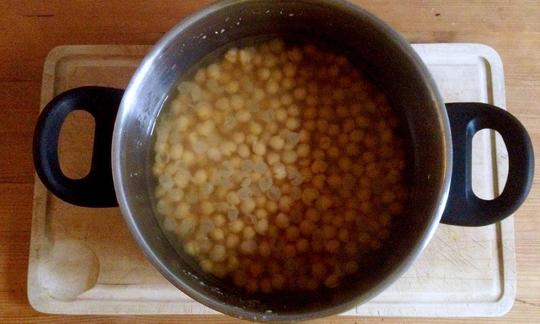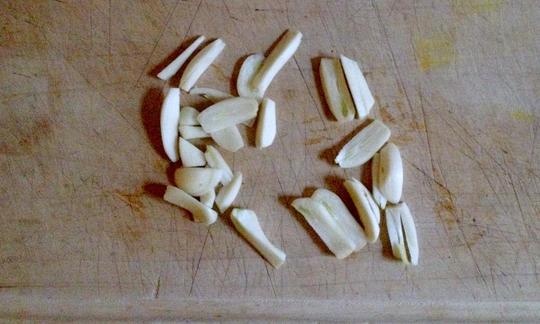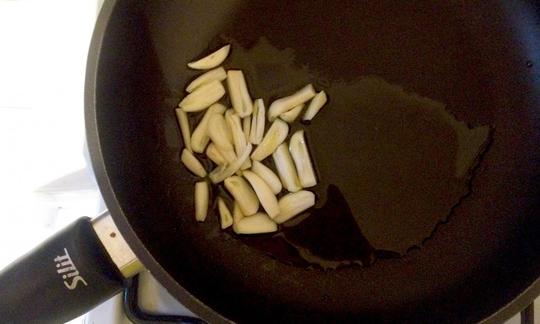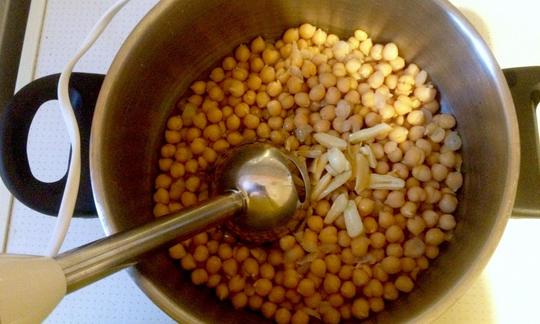Hummus with Chickpeas and Tahini
vegan
Ingredients (for servings, )
| For the chickpea base | |
|---|---|
| 8 ½ oz | Chickpeas, raw (organic?) |
| For the rest of the hummus | |
| 7 cloves | Garlic (organic?) (0.74 oz) |
| 5 tbsp | Olive oil (cold pressed, raw?, organic?) (2.4 oz) |
| 2 ½ tsp | Paprika powder, hot (raw?, organic?) (0.20 oz) |
| 1 tbsp | Tahini (sesame butter, raw?, organic?) (0.53 oz) |
| 1 tsp, whole | Cumin, seeds (raw, organic?) |
| ½ tsp | Sea salt (raw?, organic?) (0.09 oz) |
| 2 dash | Black pepper (organic?, raw?) (0.01 oz) |
| 5 tbsp | Lemon juice (raw?, organic?) (1.3 oz) |
| 130 ml | Drinking water, raw (organic?) (4.6 oz) |
Equipment
- blender or hand-held blender / immersion blender
- skillet (frying pan)
- stove
- saucepan
Type of preparation
- cook
- soak
- blend
- strain
- season to taste
- sauté
Preparation
For the chickpea base
Soak the chickpeas in plenty of fresh water for at least 12 hours or overnight — for 24 hours is even better.Chickpeas absorb a lot of water and tend to really “grow” in size — remember to take this into account when choosing the container and amount of water.
Place the chickpeas in a sieve and rinse briefly. Transfer to a large saucepan, cover with water, and cook.
The cooking time depends on how the chickpeas have been stored and for how long. For hummus, it is best to cook the chickpeas somewhat longer so that they are more soft. If the chickpeas are still al dente (slightly firm to the bite) after 1–1.5 hours of cooking time, then let them cook for a total of 2–2.5 hours. Check occasionally to make sure there is still enough water in the saucepan.
Please note: Do not add salt under any circumstances as this will considerably prolong the required cooking time!
When the chickpeas are ready, drain them in a sieve and let cool.
If you are using canned chickpeas, you can start directly with the following step.
For the rest of the hummus
Peel the garlic and cut into slices. Add to 2 tablespoons of olive oil in a nonstick skillet and fry briefly on high heat. Remove from the heat before the garlic turns brown. Remove the garlic slices and the oil from the skillet and add to the chickpeas.There are a lot of recipes where raw garlic is used instead. You can try both out and decide what tastes better to you. But if you decide to use raw garlic, you should reduce the amount as the flavor is much stronger. Then about 2–3 cloves should be enough.
Add another 3 tablespoons of olive oil, the ground paprika, tahini, ground cumin, sea salt, pepper, and lemon juice to the chickpeas.
If you instead add the salt at the end, you might need to use less.
Process everything with 130 mL water until the desired consistency is achieved. Hummus is usually a smooth cream, but there are also varieties that are somewhat more chunky — similar to peanut butter.
It usually works best to use an immersion blender. You can also use a high-speed blender (if it is powerful enough) or a food processor.
When the hummus is ready, you can season to taste or garnish with paprika or cumin.
|
Nutritional Information per person
Convert per 100g
|
2000 kcal | |
|---|---|---|
| Energy | 424 kcal | 21.2% |
| Fat/Lipids | 23 g | 32.8% |
| Saturated Fats | 3.0 g | 15.2% |
| Carbohydrates (inc.dietary fiber) | 44 g | 16.1% |
| Sugars | 7.1 g | 7.9% |
| Fiber | 8.5 g | 34.0% |
| Protein/Albumin | 14 g | 28.2% |
| Cooking Salt (Na:258.3 mg) | 656 mg | 27.3% |
| Essential micronutrients with the highest proportions | per person | 2000 kcal | |
|---|---|---|---|
| Vit | Folate, as the active form of folic acid (née vitamin B9 and | 355 µg | 177.0% |
| Min | Manganese, Mn | 1.4 mg | 69.0% |
| Prot | Threonine (Thr, T) | 0.49 g | 53.0% |
| Prot | Tryptophan (Trp, W) | 0.13 g | 52.0% |
| Min | Copper, Cu | 0.51 mg | 51.0% |
| Prot | Lysine (Lys, K) | 0.88 g | 48.0% |
| Prot | Isoleucine (Ile, I) | 0.57 g | 46.0% |
| Prot | Phenylalanine (Phe, F) | 0.71 g | 46.0% |
| Fat | Linoleic acid; LA; 18:2 omega-6 | 4.1 g | 41.0% |
| Prot | Leucine (Leu, L) | 0.95 g | 39.0% |
Detailed Nutritional Information per Person for this Recipe
The majority of the nutritional information comes from the USDA (US Department of Agriculture). This means that the information for natural products is often incomplete or only given within broader categories, whereas in most cases products made from these have more complete information displayed.
If we take flaxseed, for example, the important essential amino acid ALA (omega-3) is only included in an overarching category whereas for flaxseed oil ALA is listed specifically. In time, we will be able to change this, but it will require a lot of work. An “i” appears behind ingredients that have been adjusted and an explanation appears when you hover over this symbol.
For Erb Muesli, the original calculations resulted in 48 % of the daily requirement of ALA — but with the correction, we see that the muesli actually covers >100 % of the necessary recommendation for the omega-3 fatty acid ALA. Our goal is to eventually be able to compare the nutritional value of our recipes with those that are used in conventional western lifestyles.
| Essential fatty acids | per person | 2000 kcal |
|---|---|---|
| Linoleic acid; LA; 18:2 omega-6 | 4.1 g | 41.0% |
| Alpha-Linolenic acid; ALA; 18:3 omega-3 | 0.22 g | 11.0% |
| Essential amino acids | per person | 2000 kcal |
|---|---|---|
| Threonine (Thr, T) | 0.49 g | 53.0% |
| Tryptophan (Trp, W) | 0.13 g | 52.0% |
| Lysine (Lys, K) | 0.88 g | 48.0% |
| Isoleucine (Ile, I) | 0.57 g | 46.0% |
| Phenylalanine (Phe, F) | 0.71 g | 46.0% |
| Leucine (Leu, L) | 0.95 g | 39.0% |
| Valine (Val, V) | 0.57 g | 35.0% |
| Methionine (Met, M) | 0.18 g | 19.0% |
| Vitamins | per person | 2000 kcal |
|---|---|---|
| Folate, as the active form of folic acid (née vitamin B9 and | 355 µg | 177.0% |
| Thiamine (vitamin B1) | 0.38 mg | 34.0% |
| Vitamin B6 (pyridoxine) | 0.44 mg | 32.0% |
| Vitamin E, as a-TEs | 3.4 mg | 28.0% |
| Vitamin K | 17 µg | 23.0% |
| Pantothenic acid (vitamin B5) | 1.1 mg | 18.0% |
| Riboflavin (vitamin B2) | 0.16 mg | 12.0% |
| Vitamin C (ascorbic acid) | 7.9 mg | 10.0% |
| Biotin (ex vitamin B7, H) | 5.1 µg | 10.0% |
| Niacin (née vitamin B3) | 1.4 mg | 9.0% |
| Vitamin A, as RAE | 38 µg | 5.0% |
| Essential macroelements (macronutrients) | per person | 2000 kcal |
|---|---|---|
| Sodium, Na | 258 mg | 32.0% |
| Phosphorus, P | 203 mg | 29.0% |
| Potassium, K | 540 mg | 27.0% |
| Magnesium, Mg | 60 mg | 16.0% |
| Calcium, Ca | 61 mg | 8.0% |
| Essential trace elements (micronutrients) | per person | 2000 kcal |
|---|---|---|
| Manganese, Mn | 1.4 mg | 69.0% |
| Copper, Cu | 0.51 mg | 51.0% |
| Iron, Fe | 3.7 mg | 27.0% |
| Zinc, Zn | 2.1 mg | 21.0% |
| Iod, I (Jod, J) | 13 µg | 9.0% |
| Selenium, Se | 2.2 µg | 4.0% |
| Fluorine, F | 29 µg | 1.0% |
Basic recipe for hummus with a number of variations — here with chickpeas and tahini.
Hummus: Hummus is a Levantine dip or spread made from chickpeas. There are variations that use beans, and some recipes also contain any one of a wide range of vegetables.
The name “hummus” comes from the Arabic word for “chickpeas.” The recipe presented here is likely the most common type of hummus and can serve as a base for your own creations.
Hummus in Middle Eastern cuisine: In Middle Eastern cuisine, hummus is usually one component of a meal (often a starter) that consists of many smaller dishes. It is ideal as a dip (e.g., for vegetable sticks) and is also often used as a filling, for example, for flat bread.
Information about chickpeas: With an average of 20 g protein per 100 g, chickpeas are very high in protein and therefore a good addition to vegetables. Chickpeas (like many other legumes) are usually available in stores either dried or precooked (canned). While the canned version is of course more convenient and time-efficient, dried chickpeas that you have to cook yourself have a much better taste. And when you cook them at home, you can decide how firm you want them to be (canned chickpeas are often very soft, sometimes even mushy). In addition, canned foods often contain unnecessary additives or are already salted. It is therefore best to use the unprocessed version whenever possible.
Buying canned chickpeas: If you are going to make the quick version, then make sure to buy organic chickpeas. These are often processed more gently, and most importantly they usually contain very few or no additives at all. And it is even better to buy organic chickpeas in glass jars (organic brands often choose glass jars). These do not contain any aluminum or BPA (bisphenol A) and are more environmentally friendly.
Using dried chickpeas: The cooking time required depends on how the chickpeas have been stored and for how long. If the chickpeas have been stored for longer periods of time or at warmer temperatures (at home or the grocery store), they will need to be soaked and/or cooked for longer. Unfortunately, since you can never be sure of all of the variables, you should plan in extra time to prepare the chickpeas. Although the package directions say to cook the chickpeas for 1 hour, it can very well take 2–3 hours.
Salting: If at all, you should only add salt at the end of the cooking time, when the chickpeas are already soft. Chickpeas cook much more slowly in salted water. (You should also keep this in mind before adding soup broth as it usually contains salt.)
Serving: This fresh hummus tastes particularly good served warm with bread or hot dishes.
Possible uses: Use the hummus as a dip for fresh vegetable sticks and apple slices, as a filling for flat bread and wraps, or as a side dish with potatoes.
Quick variation: If you don’t have much time, you can also use canned chickpeas. But as explained in the Notes, this can make a big difference in terms of taste. And in the long term, it is quite a bit more expensive to buy canned goods.
Include vegetables: It is also quite delicious to add cooked or roasted vegetables to the hummus before blending. For example, the following are good choices: carrots, sweet potatoes, red bell peppers, pumpkin, eggplant, or red beets. If you make hummus on a regular basis, this is a way to add a little variety.
Eggplant Hummus: The following link will take you to our recipe for Eggplant Hummus.

